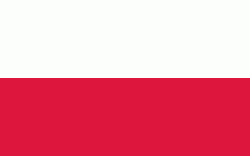Knurów
 |
 |
Knurów is located in the Silesian Highlands, on the Bierawka River, a tributary of the Oder River.
Knurów's history as a city is relatively short, as it only became a town in 1951, when also the settlements of Krywałd and Szczygłowice were included within its town limits as districts. However, Knurów's existence can be traced back as far back as ca. 1295–1305, when it was mentioned in the Liber fundationis episcopatus Vratislaviensis chronicle, and was part of Piast-ruled Poland. It was then mentioned as Knauersdorf or Cnurowicz, and later on mostly appeared in documents under its current name. Later on, it was also part of Bohemia (Czechia), Prussia and Germany. Throughout centuries, Knurów was a private village, and among its owners were the Goszycki, Węgierski and Paczyński families. The town rapidly grew at the end of the 18th century as the Industrial Revolution came and vast coal reserves were found in the area. In the late 19th century, the settlement had a population of 776. In 1904, the first mine shaft was opened, and in 1908-1909 a railway line connecting Knurów with Rybnik was built. In 1912, the first strike took place at the local mine.
After World War I, in 1918, Poland regained independence, and following the Polish Silesian Uprisings Knurów was reintegrated with Poland. In the interwar period, Knurów developed intensively. New schools, stadiums, a pipeline connecting with Bełk and the first synthetic ammonia plant in Poland were built. In 1923, a monument to the participants of the Silesian Uprisings was unveiled. The coal industry continued growing well in the 20th century, and doubled its output with a new mine being built in 1961 in Szczygłowice.
Knurów and the present-day districts of Krywałd and Szczygłowice were invaded by Germany on September 1, 1939, the first day of the invasion of Poland and World War II. Already in early September 1939, German troops committed a massacre of four Poles in Szczygłowice (see Nazi crimes against the Polish nation). During the subsequent German occupation, the occupiers established and operated two forced labour subcamps (E75, E758) of the Stalag VIII-B/344 prisoner-of-war camp in the town. A unit of the Home Army, the leading Polish resistance organization, was founded in Knurów in 1942. In January 1945, it was captured by the Soviets, who established a transit camp for local Polish Silesians who were deported to the Soviet Union (see Soviet repressions of Polish citizens (1939–1946)). Knurów was restored to Poland, although with a Soviet-installed communist regime, which then stayed in power until the Fall of Communism in the 1980s.
In 1951, Knurów was granted town rights. Several new schools were opened between 1964 and 1991, and new Catholic parishes were established in 1977–1983. More recently, in May 2015, riots ensued in the town after a Concordia Knurów fan was shot dead by police during a football match.
Map - Knurów
Map
Country - Poland
 |
 |
| Flag of Poland | |
Poland has a temperate transitional climate and its territory traverses the Central European Plain, extending from Baltic Sea in the north to Sudeten and Carpathian Mountains in the south. The longest Polish river is the Vistula, and Poland's highest point is Mount Rysy, situated in the Tatra mountain range of the Carpathians. The country is bordered by Lithuania and Russia to the northeast, Belarus and Ukraine to the east, Slovakia and the Czech Republic to the south, and Germany to the west. It also shares maritime boundaries with Denmark and Sweden.
Currency / Language
| ISO | Currency | Symbol | Significant figures |
|---|---|---|---|
| PLN | Polish złoty | zÅ‚ | 2 |
| ISO | Language |
|---|---|
| PL | Polish language |















